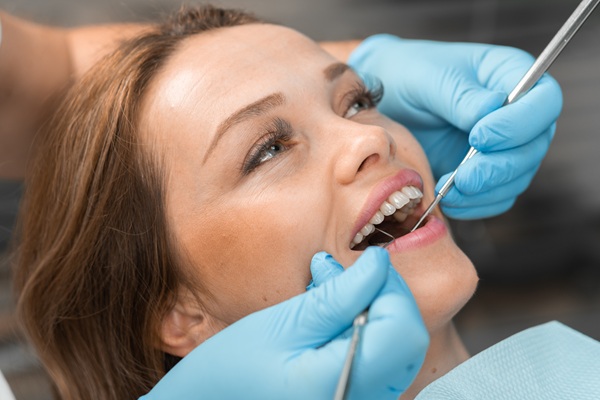3 Types of Treatment for Gum Disease

Gum disease starts with the growth of bacteria in the mouth. When brushing or flossing does not remove this bacteria, harmful plaque accumulates and hardens into tartar. The collection of tartar along the gum line results in gingivitis, which can worsen into periodontal disease. Symptoms of this disease can be mild in the early stages, so many patients do not seek care until they reach the advanced stages.
Although gum disease is a preventable condition, it remains one of the leading oral diseases in the United States. In some cases, tooth loss from advanced periodontitis is inevitable. However, with early intervention, a dentist can offer patients treatments to prevent tooth loss. Patients need to understand all treatment options so they can make an informed decision.
Common gum disease treatments
There are two main types of treatment for periodontal disease: non-surgical and surgical. Non-surgical treatment is often the first line of defense against gum disease. However, in cases of severe periodontitis, a dentist may recommend surgical treatment. There are also cosmetic treatments for gum disease that can help a patient feel more confident when smiling.
If your gum disease is in the early stages, the removal of plaque and tartar from above and below the gums may help to halt the progression of the disease and prevent the development of additional problems. This is an important diagnostic and preventive step to take prior to engaging in more extensive treatments.
1. Scaling and root planing
A type of non-surgical periodontal therapy is scaling and root planing. During this procedure, a dentist or hygienist uses scalers and curettes to clean below the gumline. These instruments remove plaque and calculus from the teeth and root surfaces.
The goal of this treatment is to disrupt harmful, disease-causing bacteria that accumulate under the gums, where it is difficult to reach with brushing alone. The dentist or hygienist may perform the procedure over several appointments, so the patient must commit to the treatment. Once the periodontal therapy is complete, the dentist and hygienist instruct the patient on proper home care for the teeth and gums.
2. Laser periodontal therapy
The National Institute of Health notes that dentists first began using dental lasers in the 1960s. However, dentists did not use lasers for periodontal treatment until the 1990s. This relatively new invention has transformed the way that dentists treat gum disease.
Laser periodontal therapy is another non-surgical intervention that dentists use to restore patients to periodontal health. The bacteria responsible for periodontal disease destroy the attachment of the gum tissue to the teeth. The goal of laser treatment is to eliminate harmful bacteria and encourage reattachment of the gums to the teeth to prevent future issues.
3. Gingival grafting and contouring
Periodontitis can cause gum recession, which makes the teeth look longer than before. Gingival grafting, a type of periodontal surgery, can cover the exposed root surfaces caused by gum recession. Because the root surface is softer than enamel, it is more sensitive. It can also be more prone to dental decay. Covering these surfaces with a gingival graft can be beneficial for the patient's overall dental health.
Some forms of gum disease can also cause gingival overgrowth, making the teeth look smaller than before. A dentist can use a laser to remove excess dental tissue. Alternatively, they may perform a surgical procedure known as a gingivectomy to eliminate extra gum tissue.
Other treatments
Additional surgical treatments are available for periodontal disease, including pocket reduction surgery, in which the gums are lifted and tartar is removed from under them. This procedure decreases the space between the teeth and gums, lessening the potential for harmful bacteria growth. This type of surgery may be combined with guided tissue regeneration, which inserts a piece of mesh between the bone and gums to prevent the gum tissue from intruding on the bone area. This enables the connective tissue to re-grow and improve support for the teeth.
Antibiotic treatments may be combined with surgery or implemented as a solo treatment to reduce the bacteria growth that accompanies gum disease. Prescription medication chlorhexidine is available as a rinse or slow-release chip to control plaque and gingivitis.
Conclusion
Gum disease is a chronic dental condition that can easily become advanced with very little warning. By maintaining proper oral hygiene and visiting the dentist regularly for professional cleaning and checkups, patients can ensure they receive an early diagnosis of gingivitis before it progresses to more serious stages. Once periodontitis becomes an issue, patients should partner with their dentist to determine the safest and right course of treatment.
Request an appointment here: https://www.culvercitydental.com or call Culver City Dental at (310) 272-5405 for an appointment in our Culver City office.
Check out what others are saying about our dental services on Yelp: Gum Disease in Culver City, CA.
Recent Posts
Receding gums can be a symptom of gum disease, or they can be caused by poor oral hygiene habits, like brushing too hard. Some people also have a genetic predisposition toward developing gum recession. Regardless of the cause, gum recession leaves teeth roots exposed to acids in the mouth. This increases their risk of decay,…
Keeping your gums healthy needs to be a key priority in your oral care routine. Effective care at home and at your dentist's office can prevent gum disease, a chronic condition that puts your overall oral health in jeopardy. Chronic or severe gum disease can lead to infections, loose teeth, and eventually permanent tooth loss.…
Most people have experienced seeing red on the bristles of their toothbrush, or a pink tint in the sink when they expectorate after brushing. It is normal to feel a bit of concern when noticing blood in the mouth because bleeding gums are a symptom commonly associated with gum disease. However, while chronic bleeding gums…
Healthy oral habits can prevent issues that may lead to infections such as gum disease. This problem, also known as gingivitis, can be common in both children and adults; however, if it is left untreated, it may worsen and cause serious discomfort or cause secondary infections within the body. Oral treatments such as scaling and…


